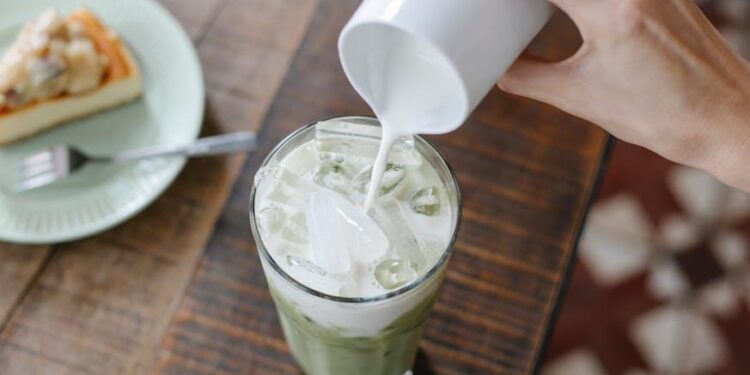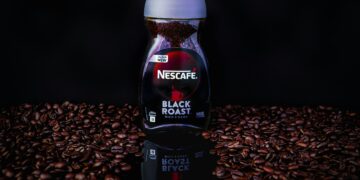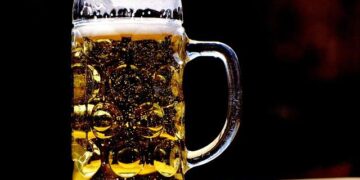Table of Contents
Part 1: The Watery Lie: My Years of Iced Coffee Disappointment
For years, I lived a lie.
Every summer, the same cycle of hope and disappointment would play out in my kitchen.
As a devoted coffee enthusiast, someone who carefully selected beans and obsessed over brew times, I believed I could conquer any coffee challenge.
Yet, the perfect glass of iced coffee remained my personal Everest—a peak I could see from afar in my favorite cafes but could never summit at home.
My journey was paved with watery, bitter failures.
I followed the so-called “standard advice” I found scattered across the internet, a litany of tips that promised café-quality results but delivered only mediocrity.
I tried the two methods most of us have attempted, each a unique path to heartbreak.
First, there was The Fridge Method.
The logic seemed simple enough: brew a large pot of hot coffee, let it cool, and stick it in the refrigerator for a ready supply of chilled coffee.
The reality, however, was a liquid tragedy.
The coffee that emerged hours later was a shadow of its former self—stale, lifeless, and possessed of a sharp, unpleasant acidity.
I didn’t know the science then, but I was experiencing the ravages of oxidation.
As the hot coffee sat cooling for hours, its delicate, aromatic oils were being irreparably damaged, creating a beverage that tasted more of regret than robusta.1
Then came The Dilution Method, a crime of passion committed in a moment of desperate craving.
I would brew a beautiful, aromatic cup of hot coffee and, in my haste, pour it directly over a glass brimming with i.e. I’d watch in horror as the ice vanished almost instantly, taking with it all the flavor, body, and character of the coffee.
What remained was a weak, watery ghost, a sad brown liquid that mocked my efforts.3
It was coffee-flavored water, a beverage of profound disappointment.
My Party Cold Brew Catastrophe
My struggle reached its nadir one sweltering July afternoon.
I was hosting a backyard party and, determined to impress my friends, decided to make a massive batch of cold brew.
I had read that it was foolproof, the go-to method for smooth, crowd-pleasing iced coffee.
I bought a dark roast, had it ground coarsely, and meticulously followed a popular recipe, steeping the grounds for a full 18 hours.
I envisioned myself as the hero of the day, dispensing perfectly chilled, delicious coffee to my grateful guests.
The reality was a catastrophe.
When I strained the brew, the resulting concentrate was murky and smelled vaguely of M.D. When I tried to dilute it, the flavor was overwhelmingly bitter and astringent, with none of the promised smoothness or chocolatey notes.
It was undrinkable.
I spent the rest of the party shamefully serving store-bought lemonade, my giant jug of failed cold brew sitting in the corner like a monument to my ignorance.
That failure was my rock bottom.
It forced me to admit that I didn’t just need a better recipe; I needed to understand what I was actually doing.
I was missing a fundamental piece of the puzzle.
Part 2: The Epiphany: Forging Coffee with Fire and Ice
The breakthrough didn’t come from a coffee blog or a barista course.
It came, unexpectedly, from the flickering light of my television.
One evening, trying to forget my coffee failures, I stumbled upon a documentary about a master blacksmith forging a knife.
I watched, mesmerized, as he explained the art of heat-treating steel.
He spoke of how he could take the exact same piece of metal and give it vastly different properties—making it incredibly hard and sharp, or tough and resilient—not by changing the metal itself, but by controlling how he heated and cooled it.
He talked about two core processes: quenching and annealing.
A lightning bolt went off in my head.
He wasn’t just working with metal; he was describing my coffee problem.
I wasn’t just adding water to grounds; I was performing a kind of thermal treatment.
The method of heating and cooling wasn’t a minor detail—it was everything.
The Analogy Unveiled: A New Paradigm for Iced Coffee
That night, I dove into the science of metallurgy and found a perfect, powerful analogy that transformed my understanding of iced coffee.
It gave me a new paradigm, a mental model that explained all my past failures and illuminated the path forward.
Quenching (The Flash Brew Method): In blacksmithing, quenching is a process of extreme transformation.
The smith heats the steel to a critical temperature, unlocking its potential, and then plunges it into a liquid like water or oil.
This rapid cooling, or “quench,” freezes the steel’s molecular structure in a highly organized, crystalline state called martensite.
The result is a material that is incredibly hard, sharp, and strong, but also brittle.
It captures the peak potential of the steel in a high-energy, complex state.6
This is precisely what happens with Flash Brew (often called Japanese Iced Coffee).
We use the intense energy of hot water (around 195-205°F) to rapidly extract the full spectrum of soluble compounds from the coffee grounds—the bright acids, the complex sugars, and the delicate, volatile aromatics.
Then, we “quench” this hot, concentrated brew by dripping it directly onto i.e. This instantaneous cooling locks in those volatile compounds before they can evaporate, preserving the coffee’s peak flavor in its most vibrant, complex, and aromatic state.4
It creates a cup that is sharp, bright, and expressive.
Annealing (The Cold Brew Method): Annealing is the opposite of quenching.
It’s a slow, gentle process.
The metal is heated and then cooled very slowly over many hours.
This allows the internal crystalline structure to relax, realign, and settle into a more stable, less stressed state.
The resulting metal is softer, more ductile, and tougher—it’s less prone to shattering.11
It trades the peak hardness of a quench for stability and forgiveness.
This is the perfect metaphor for Cold Brew.
Instead of the violent energy of heat, we use the gentle, persistent power of time.
By steeping grounds in cold or room-temperature water for 12 to 24 hours, we are performing a slow “anneal.” This gentle process extracts a different set of compounds.
It leaves behind many of the acids and oils that create bitterness and go stale quickly, resulting in a coffee that is incredibly smooth, sweet, low in acidity, and remarkably stable, with a long shelf life.9
It transforms the bean into something consistently mellow and forgiving.
This framework revealed a fundamental truth: the choice between Flash Brew and Cold Brew isn’t about which is “better.” It’s a choice between two different goals, a trade-off between control and forgiveness.
Flash Brew is an act of expression—a high-control, precise technique designed to showcase the unique, brilliant character of a specific coffee bean.
Cold Brew is an act of transformation—a low-control, forgiving method designed to turn almost any bean into a reliably smooth, convenient, and stable coffee base.
Table 1: The Two Paths of Iced Coffee: A Comparative Overview
| Attribute | Flash Brew (“The Quench”) | Cold Brew (“The Anneal”) |
| Analogy | Quenching Steel | Annealing Steel |
| Core Principle | Heat & Speed | Time & Patience |
| Flavor Profile | Bright, Aromatic, Complex, Crisp 4 | Smooth, Chocolatey, Mellow, Rich 9 |
| Acidity | High, Vibrant 4 | Very Low (up to 67% less) 1 |
| Best For | Expressing unique single-origin beans 9 | Creating a versatile, storable concentrate 12 |
| Shelf Life | Best consumed immediately; max 1-2 days 1 | Up to 2 weeks (concentrate) 12 |
| Time Investment | ~5 minutes 12 | 12-24 hours 12 |
| Caffeine | Moderate 12 | Higher (in concentrate) 9 |
Part 3: The “Quench” Method: Flash Brew for Vibrant, Aromatic Coffee
Embracing the “Quench” method was like learning to be a swordsmith.
It demands precision, the right materials, and an understanding of the forces at play.
But the reward is a cup of iced coffee with a clarity, vibrancy, and aromatic complexity that simply cannot be achieved any other Way.
The Science of the Quench: Locking in Flavor
The magic of flash brew lies in a two-part process that mirrors the quenching of steel.
First, the hot extraction.
Using water heated to the ideal range of 195-205°F (90-96°C) acts as a powerful solvent.
This heat and energy efficiently dissolve a huge array of compounds from the coffee grounds: acids that give the coffee its bright, fruity, or wine-like notes; sugars that provide sweetness; and, most importantly, the volatile aromatic oils that create the complex bouquet of flavors and smells.2
These aromatics are the soul of a great coffee, but they are incredibly fragile and begin to evaporate the moment they are exposed to air.
This leads to the second, critical step: the instantaneous chill.
By brewing the hot coffee directly onto a carefully measured amount of ice, we perform the “quench.” The temperature of the brew plummets instantly.
This rapid cooling doesn’t give those delicate, volatile compounds a chance to escape into the air.
They are trapped—or “locked in”—to the liquid.4
This is the scientific reason why flash brew tastes so alive and fragrant, while coffee that has been brewed hot and then slowly refrigerated tastes flat and dull.
The quench preserves the coffee’s just-brewed perfection.10
Choosing Your “Alloy”: The Best Beans for Flash Brewing
A blacksmith wouldn’t use any old scrap metal to forge a high-performance blade; they would select a specific steel alloy known for its ability to take a sharp edge.
Likewise, for flash brewing, you must choose your “alloy”—your coffee beans—with intention.
This method is designed to highlight nuance, so you want beans that have nuance to give.
The best choices are overwhelmingly light to medium roasts, especially single-origin coffees lauded for their bright and complex flavor profiles.9
Look for beans from these regions:
- Ethiopia: Often bursting with floral notes like jasmine and bright citrus flavors like bergamot or lemon.13
- Kenya: Known for a bold, wine-like acidity and deep fruit notes of blackcurrant or grapefruit.9
- Central America (e.g., Costa Rica, Guatemala): Typically clean, crisp, and sweet with notes of stone fruit or apple.9
The reason these beans excel is that the flash brew method, with its hot extraction and rapid chill, is perfectly suited to preserve the very characteristics—the vibrant acidity and delicate aromatics—that make these coffees special.
Using a dark, roasty bean can be counterproductive, as the method can amplify the bitter notes developed during a long roast.9
The Master’s Blueprint: A Step-by-Step Guide to Perfect Flash Brew
This is a method of precision.
Forget scoops and “eyeballing it.” Your most crucial tools are a digital scale and a burr grinder.
The scale ensures your ratios are perfect, which is the key to a balanced, non-watery brew.
The burr grinder ensures a uniform grind size for even extraction.
Essential Gear:
- Pour-over dripper (Hario V60, Chemex, Kalita Wave, etc.)
- Paper filter appropriate for your dripper
- Digital kitchen scale
- Burr grinder
- Gooseneck kettle for controlled pouring
- Carafe or sturdy mason jar to brew into
Table 2: The Flash Brew Recipe Card (for one 15oz serving)
| Component | Measurement | Notes |
| Coffee | 30 grams | Ground medium-fine (consistency of table salt) 10 |
| Ice (in carafe) | 225 grams | This is part of your total brew water |
| Hot Water | 225 grams | Heated to 195-205°F (90-96°C) 10 |
| Total Liquid | 450 grams | The sum of ice and hot water |
| Final Ratio | 1:15 | 30g coffee to 450g total liquid |
The Process:
- Prepare Your Station: Place your carafe or jar on the digital scale and tare it to zero. Add exactly 225g of ice.10
- Set Up the Brewer: Place your pour-over dripper on top of the carafe. Insert the paper filter and rinse it thoroughly with hot water to remove any paper taste and preheat the brewer. Discard this rinse water.3
- Add Coffee: Add your 30g of medium-fine ground coffee to the filter. Gently shake it to create a flat, even bed of grounds. Place the entire setup back on the scale and tare it to zero again.
- The Bloom: Start your timer. Pour about 60g of your hot water evenly over the grounds, ensuring all are saturated. You’ll see the coffee “bloom” or expand as it releases trapped CO2. Let it sit for 30-45 seconds. This is a crucial step for an even extraction.10
- The Main Pour: After the bloom, continue pouring the remaining hot water (until the scale reads 225g) over the grounds in slow, controlled circles. Avoid pouring directly on the sides of the filter. The goal is to maintain a steady, even flow.19
- Timing: The entire brewing process, from the first pour to the last drip, should take between 2 minutes 30 seconds and 3 minutes.19
- Finish and Serve: Once the water has fully drained through, remove the dripper. Give the carafe a gentle swirl to mix and fully chill the coffee with the now-partially-melted ice.19 Pour into a glass with fresh ice and enjoy immediately.
Troubleshooting the Quench: A Diagnostic Guide
Your palate is your best diagnostic tool.
Here’s how to adjust your technique:
- If it tastes weak, sour, or grassy: This indicates under-extraction. The “quench” happened before you could pull enough flavor out. The most likely culprit is your grind. Solution: Grind your coffee slightly finer for the next brew. This increases the surface area of the grounds, allowing the water to extract more flavor in the same amount of time.19 Also, double-check that your water is hot enough.
- If it tastes bitter or harsh: This indicates over-extraction. You’ve pulled too much of the bitter compounds from the grounds. Solution: Grind your coffee slightly coarser. This will reduce the surface area and slow down extraction.19 You can also try pouring more gently to reduce agitation, which can also lead to over-extraction.
Part 4: The “Anneal” Method: Cold Brew for Smooth, Forgiving Coffee
If flash brew is the art of the swordsmith, cold brew is the art of the farmer.
It is a method built on patience, not precision.
It is forgiving, reliable, and yields a product that is comforting and stable.
It is the “anneal” that transforms coffee into something fundamentally different: a smooth, mellow, low-acid elixir.
The Science of the Anneal: A Slow, Gentle Transformation
The principle of annealing is to achieve a desired state through a slow, low-energy process.
Cold brew operates on this exact principle.
By using cold or room-temperature water, we are using a much less aggressive solvent than hot water.
This has profound chemical consequences.
The cold water extracts far fewer of the compounds that contribute to perceived acidity and bitterness.
Scientific studies have shown that cold brew can have a pH as high as 6.7, making it significantly less acidic than hot-brewed coffee, which can have a pH around 5.1.1
This is why cold brew is so famously easy on the stomach.12
Furthermore, the cold water is less effective at extracting the oils that are prone to rapid oxidation.
This lack of oxidation is why cold brew concentrate has such a remarkably long shelf life—up to two weeks in the fridge—without developing the stale, rancid flavors that plague chilled hot coffee.1
What the slow, 12-to-24-hour steep does extract effectively are the coffee’s deep, inherent sweetness and the compounds that create rich, chocolatey, and nutty flavor profiles.9
It’s a gentle persuasion rather than a forceful extraction, resulting in a brew that is defined by its smooth texture and mellow character.
Choosing Your “Ingot”: The Best Beans for Cold Brewing
The annealing process is designed to create smoothness and stability, making it a perfect match for beans that are bold and robust.
You are not trying to preserve delicate floral notes here; you are trying to create a rich, smooth, foundational flavor.
The best choices for your cold brew “ingot” are generally medium to dark roasts.
These roasts have flavor profiles that align perfectly with the chocolatey, nutty, and rich character that cold brew naturally produces.13
- Regional Picks: Beans from Latin America (like Colombian Supremo or Brazilian Cerrado) and Indonesia (like Sumatra Mandheling) are classic choices, known for their low acidity and bold, earthy, or chocolatey notes.20
- Blends: Don’t shy away from blends. Many roasters create specific cold brew blends, or even espresso blends, that are formulated to produce a balanced and robust concentrate.16
- What to Avoid: Using an expensive, light-roasted Ethiopian or Kenyan bean for cold brew is often a waste. The gentle annealing process will mute the bright, sparkling acidity that makes those beans special and expensive.13
The Patient Art: A Step-by-Step Guide to Flawless Cold Brew Concentrate
Simplicity is the soul of this method.
Your primary virtues are patience and a coarse grind.
Essential Gear:
- A large container (a 2-quart mason jar, a pitcher, or a French press works well)
- A filter (fine-mesh sieve lined with cheesecloth, a nut milk bag, or a dedicated cold brew maker)
- Burr grinder (essential for a consistent coarse grind)
Table 3: The Cold Brew Recipe Card (for a batch of concentrate)
| Component | Measurement | Notes |
| Coffee | 1 part (e.g., 250g) | Ground very coarse (like coarse breadcrumbs or cornmeal) 21 |
| Cold Water | 4 to 5 parts (e.g., 1000g to 1250g) | Filtered water is best 24 |
| Ratio | 1:4 (stronger) or 1:5 (milder) | This creates a concentrate, not a ready-to-drink beverage |
| Steep Time | 12-18 hours | At room temperature. Add 4-6 hours if steeping in the fridge 24 |
The Process:
- Grind Your Beans: Set your burr grinder to its coarsest setting. This is critical. A fine grind will over-extract and create a bitter, muddy brew.14
- Combine and Steep: In your large jar or pitcher, combine the coarse coffee grounds and the cold, filtered water. Stir gently but thoroughly with a long spoon to ensure all the grounds are fully saturated.24
- Wait Patiently: Cover the container and let it steep. A good starting point is 12-18 hours on your countertop at room temperature. If you prefer to steep in the refrigerator, extend the time to at least 18-24 hours, as the cold temperature slows the extraction process.24
- Strain Slowly: After the steeping is complete, it’s time to filter. Pour the mixture slowly through your chosen filter into a clean container. The most important rule: do not press or squeeze the grounds. Let gravity do the work. Squeezing the grounds will force out bitter compounds and fine sediment, ruining the smoothness you worked so patiently to create.24
- Store the Concentrate: Transfer your finished concentrate into a sealed, airtight container and store it in the refrigerator. It will stay fresh and delicious for up to two weeks.14
- Dilute to Serve: This is the final, crucial step that many beginners miss. You have created a concentrate. It is not meant to be drunk straight. The standard dilution ratio is 1:1—one part cold brew concentrate to one part cold water or milk. Start there and adjust to your personal taste.14
Troubleshooting the Anneal: A Diagnostic Guide
Cold brew is forgiving, but not infallible.
Here’s how to diagnose issues:
- If it tastes weak, thin, or grassy: The “anneal” was too short; under-extraction. Solution: Increase the steeping time. Add another 4-6 hours to your next batch and see how it tastes.24 You can also try a slightly less coarse grind, though be careful not to go too fine.
- If it tastes bitter, muddy, or astringent: This usually points to a process flaw rather than a timing issue. Solution: Check your grind. It’s likely too fine, causing over-extraction. Go coarser next time. Also, ensure you are straining gently and not squeezing the filter.14
Part 5: The Craftsman’s Toolkit: Universal Truths for Flawless Coffee
Whether you choose the path of the Quench or the Anneal, your success rests on a foundation of universal principles.
Just as a master craftsman respects their tools and materials, a home barista must master the fundamentals.
My years of failure taught me that ignoring these pillars is the fastest way to a bad cup of coffee, no matter the method.
The Four Pillars of Extraction
These are the non-negotiable elements for quality coffee.
Get these right, and you’re 90% of the way there.
- Pillar 1: The Material (Fresh Beans): Coffee is a fresh agricultural product. Its flavor degrades over time. Always start with high-quality, recently roasted whole beans. The single biggest upgrade you can make to your coffee game is to grind your beans immediately before brewing.2 Store your beans in a cool, dark place in an airtight, opaque container—not in the fridge or freezer.2
- Pillar 2: The Cut (A Good Grind): The goal of grinding is to create particles of a uniform size for even extraction. A cheap blade grinder smashes beans into a chaotic mix of boulders and dust, leading to a brew that is simultaneously sour (from the under-extracted boulders) and bitter (from the over-extracted dust). A burr grinder, which mills the beans between two revolving abrasive surfaces, is essential for achieving the consistency required for great coffee.2
- Pillar 3: The Solvent (Quality Water): Your finished coffee is over 98% water. If your water tastes bad, your coffee will taste bad.2 Use filtered water that is free of chlorine or other off-tastes. For hot brewing methods like flash brew, temperature is also critical. Water that is too cool will under-extract; water that is boiling (212°F / 100°C) will scorch the grounds and extract bitter flavors. The ideal range is
195-205°F (90-96°C).2 - Pillar 4: The Measure (A Precise Ratio): Consistency is impossible without accurate measurement. Ditch the volume-based scoops, which are wildly inaccurate, and embrace the precision of a digital kitchen scale.10 Measuring your coffee and water in grams allows you to create a repeatable recipe and to make small, intentional adjustments when troubleshooting. It is the language of control and excellence in coffee brewing.
Mastering these four pillars is what separates the amateur from the craftsman.
They are the foundation upon which both the rapid Quench and the patient Anneal are built.
Part 6: Conclusion: Forging Your Own Perfect Cup
My journey into the world of iced coffee began with a series of watery, bitter failures and culminated in the humiliating “party catastrophe.” I was lost, following disconnected rules without understanding the principles behind them.
The answer, I discovered, wasn’t in a better recipe but in a better way of thinking.
The blacksmith’s forge gave me the framework I needed: the powerful dichotomy of Quenching versus Annealing.
This paradigm shifted my perspective entirely.
I no longer saw two random methods; I saw two distinct philosophies of extraction, each with its own purpose, materials, and ideal outcome.
Flash Brew, the Quench, is a high-energy, precision craft for capturing the vibrant, fleeting soul of a brilliant coffee bean.
Cold Brew, the Anneal, is a patient, transformative process for creating a reliably smooth and stable foundation.
The Taste of Success
Armed with this new understanding, I tried again.
I bought a bag of single-origin Ethiopian Yirgacheffe beans, noted for their bright, floral character.
I chose the path of the Quench.
I weighed my beans and ice with the precision of an apothecary, ground the coffee to a perfect medium-fine, and heated my water to exactly 200°F.
As I performed the pour-over, watching the concentrated, fragrant brew drip onto the ice below, I felt like a craftsman executing a well-honed technique.
The first sip was the epiphany made real.
It was everything I had been chasing for years.
The coffee was not watery or bitter.
It was bright, clean, and alive with flavor.
I could taste the promised notes of jasmine and lemon, a sparkling acidity balanced by a delicate sweetness.
It was complex, refreshing, and utterly delicious.
I had not just followed a recipe; I had applied a principle and forged a perfect cup of coffee.
My final message to you is this: you now hold the craftsman’s toolkit.
You have the framework to move beyond simply following instructions and to start thinking like a barista.
See your beans as the alloy, your water as the solvent, and your method as a form of thermal treatment.
Ask yourself what you want to achieve: are you looking to express the unique character of a specific bean, or transform it into a smooth, convenient staple?
Embrace experimentation.
Try a bright Kenyan coffee as a flash brew.
Try a dark Sumatran as a cold brew.
Adjust your grind, tweak your ratios, and taste the results.
The path to your personal perfect cup is now clear.
Go forth and forge.
Works cited
- Iced Coffee vs Cold Brew: What’s the REAL difference? – YouTube, accessed August 7, 2025, https://www.youtube.com/watch?v=GrAZrB3o8oU
- 5 Iced Coffee Mistakes You’re Probably Making – EatingWell, accessed August 7, 2025, https://www.eatingwell.com/iced-coffee-mistakes-youre-probably-making-11786483
- Baristas Share People’s Biggest Mistakes Making Iced Coffee – CoffeeTalk, accessed August 7, 2025, https://coffeetalk.com/daily-dose/for-roasters-retailers/06-2024/103383/
- Iced Coffee vs Cold Brew: A Quick Breakdown, accessed August 7, 2025, https://www.drivencoffee.com/blogs/blog/iced-coffee-vs-cold-brew-quick-breakdown
- how to make iced drinks that aren’t watered down – desperate new manager here : r/Coffee, accessed August 7, 2025, https://www.reddit.com/r/Coffee/comments/bxaloq/how_to_make_iced_drinks_that_arent_watered_down/
- What Is Quenching And Tempering In Metals – And How Does It Work – Fidelis Engineering Associates, accessed August 7, 2025, https://www.fidelisfea.com/post/what-is-quenching-and-tempering-in-metals-and-how-does-it-work
- Quenching and Tempering | HÄRTHA GROUP, accessed August 7, 2025, https://haertha.de/en/process/quenching-and-tempering/
- Learn About Quenching & Tempering – Clifton Steel, accessed August 7, 2025, https://www.cliftonsteel.com/education/quenching-tempering
- Summer Brewing Methods Showdown: Cold Brew vs. Flash Brew vs. Iced Pour-Over, accessed August 7, 2025, https://www.secondbestcoffee.com/blog/2025/5/25/summer-brewing-methods-showdown-cold-brew-vs-flash-brew-vs-iced-pour-over
- Japanese-Style Iced Coffee Recipe – Serious Eats, accessed August 7, 2025, https://www.seriouseats.com/japanese-style-iced-coffee
- Understanding Metal Heat Treating Fundamentals, accessed August 7, 2025, https://jfheattreatinginc.com/2023/12/understanding-metal-heat-treating-fundamentals/
- Cold brew vs Iced Coffee – Espresso Academy, accessed August 7, 2025, https://espressoacademy.it/en/coffee-guide/cold-brew-vs-iced-coffe/
- Cold Brew vs Iced Coffee: A Simplified Guide, accessed August 7, 2025, https://www.drinktrade.com/blogs/education/cold-brew-vs-iced-coffee
- Cold Brew At Home: 5 Mistakes To Avoid When Making Yours – Wake The Crew, accessed August 7, 2025, https://www.wakethecrewcoffee.com/blogs/news/cold-brew-at-home-5-mistakes-to-avoid-when-making-yours
- How To Make Iced Pour Over Coffee – Flash Brew – YouTube, accessed August 7, 2025, https://www.youtube.com/watch?v=OimennzoLsw
- Best Coffee Beans for Cold Brew – Blends and Single Origin, accessed August 7, 2025, https://thatscoldbrew.com/best-coffee-for-cold-brew/
- Japanese Iced Coffee How To – CoffeeGeek, accessed August 7, 2025, https://coffeegeek.com/guides/howtos/japanese-iced-coffee-how-to/
- Flash-Chilled Pour Over – Brew Guide – Kunjani Craft Coffee, accessed August 7, 2025, https://kunjaninaples.com/blogs/brew-guide/flash-chilled-pour-over
- This V60 Japanese Iced Coffee Hack Will Change Your Summer Forever! – YouTube, accessed August 7, 2025, https://www.youtube.com/watch?v=21ZxyXSKN9E&pp=0gcJCfwAo7VqN5tD
- What Are the Best Coffee Beans for Cold Brew? – Green Coffee …, accessed August 7, 2025, https://www.ictcoffee.com/news/what-are-the-best-coffee-beans-for-cold-brew/
- What are the Best Coffee Beans for Cold Brew?, accessed August 7, 2025, https://www.perkatoryroasters.com/blogs/news/what-are-the-best-coffee-beans-for-cold-brew
- The Best Coffee for Cold Brew with a Recipe – Braised & Deglazed, accessed August 7, 2025, https://braisedanddeglazed.com/the-best-coffee-for-cold-brew-with-a-recipe/
- Roasted & Ground For Cold Brew – Lucky Goat Coffee, accessed August 7, 2025, https://luckygoatcoffee.com/collections/cold-brew-grind
- Six Common Mistakes When Making Cold Brew Coffee, accessed August 7, 2025, https://groundsandhoundscoffee.com/blogs/recent-posts/six-common-mistakes-when-making-cold-brew-coffee
- The Water Ratio Mistake That’s Breaking Your Iced Coffee – Food Republic, accessed August 7, 2025, https://www.foodrepublic.com/1382273/iced-coffee-ratio-mistake-home-brewing/






